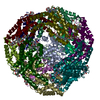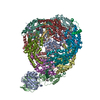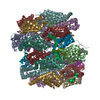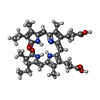[English] 日本語
 Yorodumi
Yorodumi- PDB-8to2: Bottom cylinder of high-resolution phycobilisome quenched by OCP ... -
+ Open data
Open data
- Basic information
Basic information
| Entry | Database: PDB / ID: 8to2 | |||||||||||||||
|---|---|---|---|---|---|---|---|---|---|---|---|---|---|---|---|---|
| Title | Bottom cylinder of high-resolution phycobilisome quenched by OCP (local refinement) | |||||||||||||||
 Components Components |
| |||||||||||||||
 Keywords Keywords | PHOTOSYNTHESIS / Complex / light harvesting / pigment | |||||||||||||||
| Function / homology |  Function and homology information Function and homology informationlight absorption / Lyases / phycobilisome / chloride ion binding / plasma membrane-derived thylakoid membrane / photoreceptor activity / photosynthesis / lyase activity Similarity search - Function | |||||||||||||||
| Biological species |  | |||||||||||||||
| Method | ELECTRON MICROSCOPY / single particle reconstruction / cryo EM / Resolution: 2 Å | |||||||||||||||
 Authors Authors | Sauer, P.V. / Sutter, M. / Cupellini, L. | |||||||||||||||
| Funding support | European Union,  United States, United States,  Czech Republic, 4items Czech Republic, 4items
| |||||||||||||||
 Citation Citation |  Journal: Sci Adv / Year: 2024 Journal: Sci Adv / Year: 2024Title: Structural and quantum chemical basis for OCP-mediated quenching of phycobilisomes. Authors: Paul V Sauer / Lorenzo Cupellini / Markus Sutter / Mattia Bondanza / María Agustina Domínguez Martin / Henning Kirst / David Bína / Adrian Fujiet Koh / Abhay Kotecha / Basil J Greber / ...Authors: Paul V Sauer / Lorenzo Cupellini / Markus Sutter / Mattia Bondanza / María Agustina Domínguez Martin / Henning Kirst / David Bína / Adrian Fujiet Koh / Abhay Kotecha / Basil J Greber / Eva Nogales / Tomáš Polívka / Benedetta Mennucci / Cheryl A Kerfeld /      Abstract: Cyanobacteria use large antenna complexes called phycobilisomes (PBSs) for light harvesting. However, intense light triggers non-photochemical quenching, where the orange carotenoid protein (OCP) ...Cyanobacteria use large antenna complexes called phycobilisomes (PBSs) for light harvesting. However, intense light triggers non-photochemical quenching, where the orange carotenoid protein (OCP) binds to PBS, dissipating excess energy as heat. The mechanism of efficiently transferring energy from phycocyanobilins in PBS to canthaxanthin in OCP remains insufficiently understood. Using cryo-electron microscopy, we unveiled the OCP-PBS complex structure at 1.6- to 2.1-angstrom resolution, showcasing its inherent flexibility. Using multiscale quantum chemistry, we disclosed the quenching mechanism. Identifying key protein residues, we clarified how canthaxanthin's transition dipole moment in its lowest-energy dark state becomes large enough for efficient energy transfer from phycocyanobilins. Our energy transfer model offers a detailed understanding of the atomic determinants of light harvesting regulation and antenna architecture in cyanobacteria. | |||||||||||||||
| History |
|
- Structure visualization
Structure visualization
| Structure viewer | Molecule:  Molmil Molmil Jmol/JSmol Jmol/JSmol |
|---|
- Downloads & links
Downloads & links
- Download
Download
| PDBx/mmCIF format |  8to2.cif.gz 8to2.cif.gz | 2.1 MB | Display |  PDBx/mmCIF format PDBx/mmCIF format |
|---|---|---|---|---|
| PDB format |  pdb8to2.ent.gz pdb8to2.ent.gz | 1.4 MB | Display |  PDB format PDB format |
| PDBx/mmJSON format |  8to2.json.gz 8to2.json.gz | Tree view |  PDBx/mmJSON format PDBx/mmJSON format | |
| Others |  Other downloads Other downloads |
-Validation report
| Summary document |  8to2_validation.pdf.gz 8to2_validation.pdf.gz | 2.8 MB | Display |  wwPDB validaton report wwPDB validaton report |
|---|---|---|---|---|
| Full document |  8to2_full_validation.pdf.gz 8to2_full_validation.pdf.gz | 2.9 MB | Display | |
| Data in XML |  8to2_validation.xml.gz 8to2_validation.xml.gz | 136.8 KB | Display | |
| Data in CIF |  8to2_validation.cif.gz 8to2_validation.cif.gz | 199.3 KB | Display | |
| Arichive directory |  https://data.pdbj.org/pub/pdb/validation_reports/to/8to2 https://data.pdbj.org/pub/pdb/validation_reports/to/8to2 ftp://data.pdbj.org/pub/pdb/validation_reports/to/8to2 ftp://data.pdbj.org/pub/pdb/validation_reports/to/8to2 | HTTPS FTP |
-Related structure data
| Related structure data |  41434MC  8to5C  8tpjC  8troC M: map data used to model this data C: citing same article ( |
|---|---|
| Similar structure data | Similarity search - Function & homology  F&H Search F&H Search |
- Links
Links
- Assembly
Assembly
| Deposited unit | 
|
|---|---|
| 1 |
|
- Components
Components
-Protein , 3 types, 3 molecules ABp
| #1: Protein | Mass: 100412.703 Da / Num. of mol.: 1 / Source method: isolated from a natural source / Source: (natural)  |
|---|---|
| #2: Protein | Mass: 34684.605 Da / Num. of mol.: 1 / Source method: isolated from a natural source / Source: (natural)  |
| #9: Protein | Mass: 12927.983 Da / Num. of mol.: 1 / Source method: isolated from a natural source / Source: (natural)  |
-Phycobilisome ... , 2 types, 3 molecules CcP
| #3: Protein | Mass: 7817.174 Da / Num. of mol.: 2 / Source method: isolated from a natural source / Source: (natural)  #6: Protein | | Mass: 28938.758 Da / Num. of mol.: 1 / Source method: isolated from a natural source / Source: (natural)  |
|---|
-Allophycocyanin ... , 4 types, 23 molecules DFHJLNfhjlEGIKMOegikmdo
| #4: Protein | Mass: 17429.807 Da / Num. of mol.: 10 / Source method: isolated from a natural source / Source: (natural)  #5: Protein | Mass: 17231.604 Da / Num. of mol.: 11 / Source method: isolated from a natural source / Source: (natural)  #7: Protein | | Mass: 17940.393 Da / Num. of mol.: 1 / Source method: isolated from a natural source / Source: (natural)  #8: Protein | | Mass: 18911.424 Da / Num. of mol.: 1 / Source method: isolated from a natural source / Source: (natural)  |
|---|
-Non-polymers , 2 types, 25 molecules 


| #10: Chemical | ChemComp-CYC / #11: Chemical | ChemComp-45D / | |
|---|
-Details
| Has ligand of interest | Y |
|---|---|
| Has protein modification | Y |
-Experimental details
-Experiment
| Experiment | Method: ELECTRON MICROSCOPY |
|---|---|
| EM experiment | Aggregation state: PARTICLE / 3D reconstruction method: single particle reconstruction |
- Sample preparation
Sample preparation
| Component | Name: Complex of phycobilisome from Synechocystis PCC 6803 bound to OCP Type: COMPLEX / Entity ID: #1-#9 / Source: NATURAL |
|---|---|
| Molecular weight | Experimental value: NO |
| Source (natural) | Organism:  |
| Buffer solution | pH: 7.5 |
| Specimen | Conc.: 3.8 mg/ml / Embedding applied: NO / Shadowing applied: NO / Staining applied: NO / Vitrification applied: YES |
| Vitrification | Instrument: FEI VITROBOT MARK IV / Cryogen name: ETHANE-PROPANE / Details: Manual blotting |
- Electron microscopy imaging
Electron microscopy imaging
| Experimental equipment |  Model: Titan Krios / Image courtesy: FEI Company |
|---|---|
| Microscopy | Model: TFS KRIOS |
| Electron gun | Electron source:  FIELD EMISSION GUN / Accelerating voltage: 300 kV / Illumination mode: OTHER FIELD EMISSION GUN / Accelerating voltage: 300 kV / Illumination mode: OTHER |
| Electron lens | Mode: BRIGHT FIELD / Nominal defocus max: 1200 nm / Nominal defocus min: 400 nm |
| Specimen holder | Cryogen: NITROGEN |
| Image recording | Electron dose: 40 e/Å2 / Film or detector model: FEI FALCON IV (4k x 4k) |
- Processing
Processing
| EM software |
| ||||||||||||||||||||||||
|---|---|---|---|---|---|---|---|---|---|---|---|---|---|---|---|---|---|---|---|---|---|---|---|---|---|
| Image processing | Details: Streptavidin lattice was subtracted after movie alignment | ||||||||||||||||||||||||
| CTF correction | Type: PHASE FLIPPING AND AMPLITUDE CORRECTION | ||||||||||||||||||||||||
| 3D reconstruction | Resolution: 2 Å / Resolution method: FSC 0.143 CUT-OFF / Num. of particles: 153576 / Symmetry type: POINT | ||||||||||||||||||||||||
| Refinement | Cross valid method: NONE Stereochemistry target values: GeoStd + Monomer Library + CDL v1.2 | ||||||||||||||||||||||||
| Displacement parameters | Biso mean: 19.17 Å2 | ||||||||||||||||||||||||
| Refine LS restraints |
|
 Movie
Movie Controller
Controller







 PDBj
PDBj


